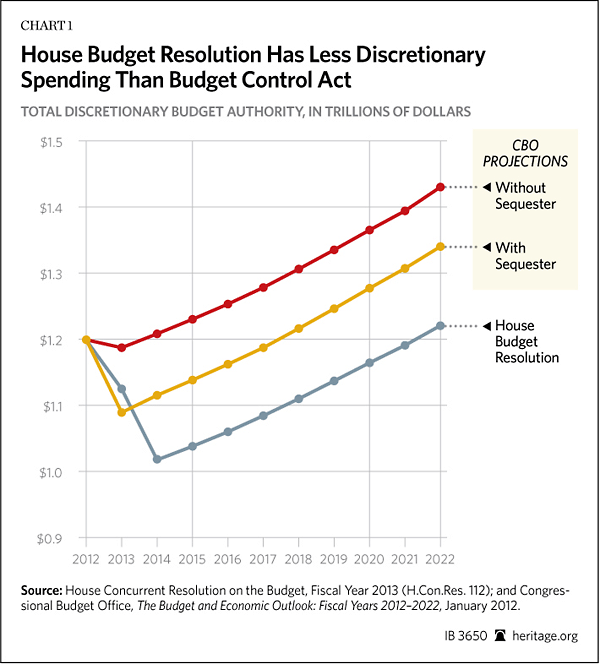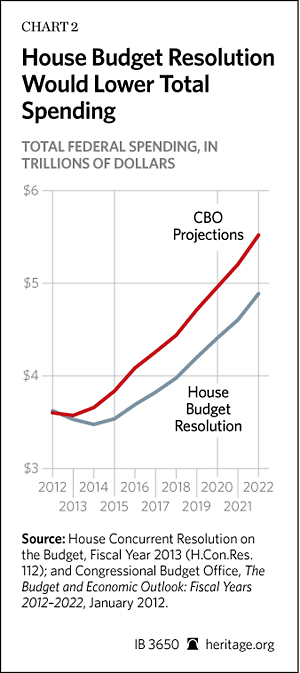With several extraordinary spending and tax challenges facing Congress, at least one part of this year’s budgeting should be fairly routine: the annual appropriations process. Both the House and the Senate have already advanced many of these spending bills, which fund the operations of government agencies. They should make a point of completing them all in a deliberate, orderly process. There is no excuse for putting them off to another massive omnibus bill passed in an end-of-year lame-duck session.
An orderly approach would have two key benefits: (1) It would begin to restore some command of congressional budgeting, which has suffered from the past several years of dysfunction, and (2) it would improve the chances of holding spending down.
The Need for the Regular Order
After failing once again to pass a budget resolution, Senate leaders defaulted to the Budget Control Act (BCA)—the product of last year’s debt ceiling agreement—for their total fiscal year (FY) 2013 appropriations level. The BCA officially caps this “discretionary” spending at $1.047 trillion, $19 billion higher than the $1.028 trillion figure established in the House-passed budget resolution (H. Con. Res. 112). Consequently, the House and Senate also have different subtotals divided among the dozen discretionary spending bills, as shown in The Heritage Foundation’s Appropriations Tracker.[1]
Such differences are not unusual. The two chambers often distribute spending amounts differently even when they agree on the total—as they would under a concurrent budget resolution agreed to by both bodies. This year, the disparities are merely larger; they still have to be resolved one way or another. It should be done by the “regular order.” That means both chambers should pass each of their 12 respective appropriations bills individually, they should reach stand-alone, bicameral agreements (conference reports) on each, and they should pass each final agreement separately and in time for them to be enacted by the start of the fiscal year on October 1. Sadly, this has not been accomplished since 1995, and since then, fiscal conditions have clearly worsened.
The alternative of delay (possibly until very late in the calendar year) will only tempt appropriators toward higher spending to win quick, eleventh-hour agreements—as occurred last December.
Besides, lawmakers already face some huge and unusual budgetary challenges this year. Among them are an automatic across-the-board spending cut (“sequestration”), required by the BCA, that would recklessly slash defense spending; “Taxmageddon,” the harmful series of scheduled tax hikes totaling nearly $500 billion in 2013 alone[2]; and possibly the need for another debt ceiling increase. This looming “fiscal cliff” makes it all the more urgent for Congress to complete the far more routine appropriations process in an orderly fashion, and this is entirely within reach.[3]
A Step Toward Spending Control
Uncontrolled government spending is fueling a publicly held debt that could swell to twice the size of the entire economy.[4] While runaway federal entitlements are the main culprits, appropriations—representing roughly one-third of the budget—have made their own contribution. Even after adjusting for inflation, discretionary spending, excluding defense, is 20 percent higher than it was just 10 years ago and 53 percent higher than two decades ago. Indeed, this spending remains nearly 10 percent higher today than in 2008, just before the stimulus and bailout spending binge.
Considering these increases—and in an era of chronic trillion-dollar deficits—the question is not where to cut; it is, instead: What activities truly require federal funds? Tight spending limits compel the necessary choices of priorities.
In that respect, the House-passed budget levels are clearly preferable to the Senate’s chosen caps. When extended over 10 years, the House budget’s discretionary limit spends $1.8 trillion less than the Senate’s plan—and even less than the caps and sequestration put together. The House budget achieves lower spending through reasoned, deliberate choices—not some blind, automatic mechanism.
The House budget takes significant steps toward tackling the government’s looming fiscal crisis and is the only budget resolution to have passed in a chamber of Congress. Both the House and Senate should adhere to its lower spending levels.


Further, the Senate spending caps are riddled with loopholes. Not only are they higher than the House’s, but they also bristle with various euphemistically termed “adjustments” that allow spending beyond the advertised $1.047 trillion limit for 2013. One such loophole is a “disaster relief” exemption for weather events that have already occurred and hence should be budgeted for.[5] The Senate plans $6.7 billion in such excess “disaster” spending, making a mockery of its spending limits. The disaster spending is in addition to a separate, often-abused escape hatch that Congress can employ any time during the year, in any amount, for events it deems “emergencies.”
Regrettably, House appropriators, too, have employed the “disaster” gimmick to the tune of $5.5 billion—even though the House budget resolution eliminates this exception,[6] as does legislation introduced by Representative Doug Lamborn (R–CO).[7] But Budget Committee chairman Paul D. Ryan (R–WI) then exercised his authority to lower the Appropriations Committee’s overall allocation so that it will have to offset the increase in subsequent legislation. Both chambers should just discard such gimmicks and adhere to the House budget resolution levels without loopholes.
Moreover, spending limits are ceilings, not floors. In a creative linguistic contortion, Senate Majority Leader Harry Reid (D–NV) has tried to argue that spending less than the Senate’s BCA-based caps would amount to reneging on the debt-ceiling deal. This view defies the language and practice of congressional budgeting—not to mention common sense.
The BCA itself expressly anticipates the expiration of the BCA levels “if a concurrent resolution on the budget for fiscal year 2013 is agreed to by the Senate and House of Representatives.” Only the Senate’s negligence prevents this from happening.
Budget Discipline Needed
As congressional budgeting has unraveled in recent years, the government’s fiscal health has worsened. Restoring both will require a sustained effort.
The Appropriations Committees can best contribute by following through on what they have begun: completing each of their spending bills separately, on time, and in the manner envisioned by the Congressional Budget Act. There is no legitimate reason for another high-cost, end-of-year debacle over these annual spending bills. If they run late, it will be the result not of a “broken” budget process and not of circumstance but of a deliberate choice.
Patrick Louis Knudsen is the Grover M. Hermann Fellow in Federal Budgetary Affairs in the Thomas A. Roe Institute for Economic Policy Studies at The Heritage Foundation.


